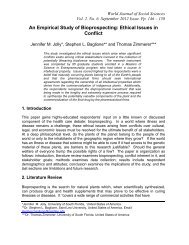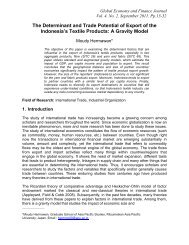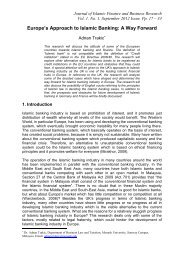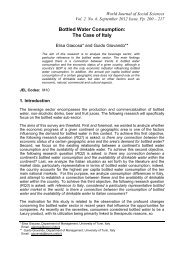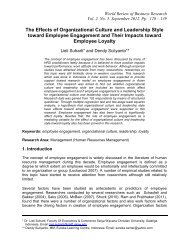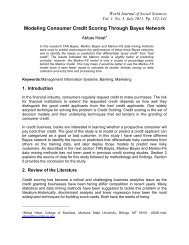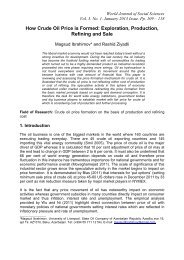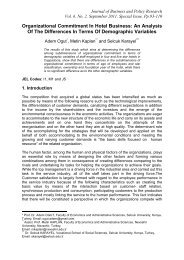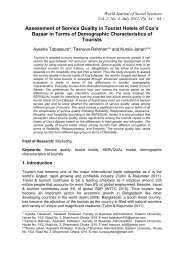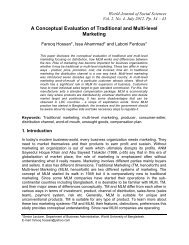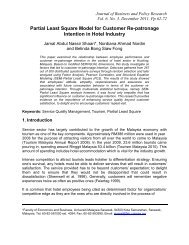Abdullah, Shamsher & Chowdhuryaugmented Dickey-Fuller (ADF) tests. The ADF tests are unable to differentiate wellbetween non-stationary <strong>and</strong> stationary series with a high degree <strong>of</strong> autocorrelation(West, 1988) <strong>and</strong> are sensitive to structural breaks (Culver <strong>and</strong> Papell, 1997). Paul,Kearney <strong>and</strong> Chowdhury (1997) also did not <strong>in</strong>clude any error correction model to check<strong>the</strong> existence <strong>of</strong> any long-run relationship. The Error Correction Model (ECM) test isessential to see whe<strong>the</strong>r an economy is converg<strong>in</strong>g towards equilibrium <strong>in</strong> <strong>the</strong> long runor not. The ECM also shows short-run dynamics.Although <strong>the</strong> relationships among <strong><strong>in</strong>flation</strong>, output growth, <strong><strong>in</strong>flation</strong> uncerta<strong>in</strong>ty <strong>and</strong>output uncerta<strong>in</strong>ty have been <strong>in</strong>vestigated extensively <strong>in</strong> <strong>the</strong> empirical literature fordeveloped countries (e.g., Grier <strong>and</strong> Perry 1998; Davis <strong>and</strong> Kanago, 2000; Fountas etal. 2006; Fountas <strong>and</strong> Karanasos 2007)2, a lesser work is done for economies <strong>in</strong>transition. Few exceptions are Gillman <strong>and</strong> Nakov (2004), Dibooglu <strong>and</strong> Kutan (2005),Gillman <strong>and</strong> Harris (2008), Mladenovic (2007), Thornton (2007), Erkam <strong>and</strong> Cavusoglu(2008), <strong>and</strong> Susjan <strong>and</strong> Redek (2008). Gillman <strong>and</strong> Nakov (2004) exam<strong>in</strong>ed <strong>the</strong>relationship between <strong><strong>in</strong>flation</strong> <strong>and</strong> output growth <strong>in</strong> Hungary <strong>and</strong> Pol<strong>and</strong>, <strong>and</strong> found that<strong><strong>in</strong>flation</strong> affects growth negatively <strong>in</strong> both countries. Gillman <strong>and</strong> Harris (2008) als<strong>of</strong>ound a robust negative effect <strong>of</strong> <strong><strong>in</strong>flation</strong> on growth <strong>in</strong> a panel <strong>of</strong> 13 transition countries.Dibooglu <strong>and</strong> Kutan (2005) studied <strong>the</strong> sources <strong>of</strong> <strong><strong>in</strong>flation</strong> <strong>and</strong> output movements <strong>in</strong>Pol<strong>and</strong> <strong>and</strong> Hungary, <strong>and</strong> found that monetary shocks affect output <strong>in</strong> Hungary, whilesupply shocks dom<strong>in</strong>ate output movements <strong>in</strong> Pol<strong>and</strong>.Mladenovic (2007) exam<strong>in</strong>ed <strong>the</strong> relationship between <strong><strong>in</strong>flation</strong> <strong>and</strong> <strong><strong>in</strong>flation</strong> uncerta<strong>in</strong>ty<strong>in</strong> Serbia, <strong>and</strong> concluded that high <strong><strong>in</strong>flation</strong> <strong>in</strong>vokes high uncerta<strong>in</strong>ty, while highuncerta<strong>in</strong>ty negatively affects average level <strong>of</strong> <strong><strong>in</strong>flation</strong> <strong>in</strong> <strong>the</strong> long run. Thornton (2007)studied <strong>the</strong> <strong><strong>in</strong>flation</strong> <strong>and</strong> <strong><strong>in</strong>flation</strong> uncerta<strong>in</strong>ty relationship for 12 emerg<strong>in</strong>g economies<strong>in</strong>clud<strong>in</strong>g Hungary, <strong>and</strong> found that <strong>the</strong>re is positive bidirectional causality between<strong><strong>in</strong>flation</strong> <strong>and</strong> <strong><strong>in</strong>flation</strong> uncerta<strong>in</strong>ty <strong>in</strong> <strong>the</strong> case <strong>of</strong> Hungary. Erkam <strong>and</strong> Cavusoglu (2008)<strong>in</strong>vestigated <strong>the</strong> l<strong>in</strong>kage between <strong><strong>in</strong>flation</strong> <strong>and</strong> <strong><strong>in</strong>flation</strong> uncerta<strong>in</strong>ty <strong>in</strong> seven formerSoviet Union countries. They found that <strong><strong>in</strong>flation</strong> rate <strong>in</strong>creases uncerta<strong>in</strong>ty <strong>in</strong> threecountries (Azerbaijan, Russia, <strong>and</strong> Ukra<strong>in</strong>e) while uncerta<strong>in</strong>ty <strong>in</strong>creases average<strong><strong>in</strong>flation</strong> <strong>in</strong> Kyrgyzstan <strong>and</strong> Russia, but reduces it <strong>in</strong> Azerbaijan. F<strong>in</strong>ally, Susjan <strong>and</strong>Redek (2008) provide strong evidence on negative effect <strong>of</strong> transition specificuncerta<strong>in</strong>ties on economic growth for a panel <strong>of</strong> 22 transition countries. We will focus onmacroeconomic factors (transportation cost, oil price, food production, political stabilityetc) that might cause <strong><strong>in</strong>flation</strong>.3. Study MethodsThis article is ma<strong>in</strong>ly based on secondary <strong>in</strong>formation. Hakim (2000) suggestedcomb<strong>in</strong><strong>in</strong>g secondary data from various sources to <strong>in</strong>crease <strong>the</strong> validity <strong>of</strong> <strong>the</strong><strong>in</strong>formation. The research design has been conducted by secondary data method toanalyze <strong><strong>in</strong>flation</strong> pattern <strong>of</strong> Bangladesh. Secondary data have been collected ma<strong>in</strong>lyfrom journals, books <strong>and</strong> previous studies. Suitable data have been extracted,<strong>org</strong>anized, analyzed, illustrated <strong>and</strong> <strong>in</strong>terpreted <strong>in</strong> <strong>the</strong> report with proper reason<strong>in</strong>g,analytical judgment, clarification <strong>and</strong> explanation. So we don‟t need <strong>the</strong> sample size.Research has been conducted on <strong>the</strong> basis <strong>of</strong> 2000-2011 <strong><strong>in</strong>flation</strong> data frame <strong>in</strong> <strong>the</strong>context <strong>of</strong> Bangladesh. The reasons to choose data between this time frame is toanalyze <strong><strong>in</strong>flation</strong> <strong>in</strong> recent context especially <strong>in</strong> <strong>the</strong> light <strong>of</strong> global scenario after 9/11attack. After 2001, world politics <strong>and</strong> food production scenario are mov<strong>in</strong>g <strong>in</strong> newdimension. Recent Arab spr<strong>in</strong>g is also contribut<strong>in</strong>g reshap<strong>in</strong>g <strong>the</strong> world scenario <strong>and</strong>politics. Researchers do not follow any particular model to analyze, because our aim is93
Abdullah, Shamsher & Chowdhurynot to build any relationship. Researchers participatory observed <strong>the</strong> current world <strong>and</strong>Bangladesh scenario as well as analyze secondary data sources to f<strong>in</strong>d out <strong>the</strong>reason<strong>in</strong>g.The research has been presented <strong>in</strong> written form <strong>in</strong> this article to <strong>in</strong>terpret <strong>the</strong><strong>in</strong>formation ga<strong>the</strong>red <strong>and</strong> convey <strong>the</strong> research f<strong>in</strong>d<strong>in</strong>gs. The article has been made bypopular report<strong>in</strong>g <strong>in</strong> order to facilitate <strong>the</strong> readers <strong>in</strong> better underst<strong>and</strong><strong>in</strong>g <strong>of</strong> <strong>the</strong> report.No technical terms have been used <strong>in</strong> <strong>the</strong> <strong>study</strong>. However, researchers do not f<strong>in</strong>d anyholistic <strong>study</strong> relevant to this filed that can help government to implement policy <strong>in</strong> nextdecade. This qualitative <strong>study</strong> is improved <strong>study</strong> <strong>in</strong> <strong>the</strong> light <strong>of</strong> recent world scenario <strong>and</strong>it will give a clear direction for next era.4. Results <strong>and</strong> Discussions4.1 F<strong>in</strong>d<strong>in</strong>gs <strong>of</strong> Objective IInflation Scenario <strong>in</strong> BangladeshExperience <strong>of</strong> high <strong><strong>in</strong>flation</strong> is not new <strong>in</strong> Bangladesh. The country experienced asignificant rise <strong>in</strong> <strong>the</strong> <strong><strong>in</strong>flation</strong> rate <strong>in</strong> <strong>the</strong> recent past. The table I <strong>and</strong> accompany<strong>in</strong>ggraph (figure II) <strong>in</strong> appendix summarize <strong>the</strong> <strong><strong>in</strong>flation</strong> scenario <strong>of</strong> Bangladesh for <strong>the</strong> lastdecade.In Bangladesh <strong>the</strong> average <strong><strong>in</strong>flation</strong> (general) <strong>in</strong> FY 2000 was 1.94% while it is found9.76% <strong>in</strong> FY 2011. But dur<strong>in</strong>g <strong>the</strong>se years changes <strong>in</strong> <strong><strong>in</strong>flation</strong> did not follow anymonotonic pattern. Bangladesh faces a tougher challenge <strong>in</strong> br<strong>in</strong>g<strong>in</strong>g down burgeon<strong>in</strong>g<strong><strong>in</strong>flation</strong>. The latest Bangladesh Bureau <strong>of</strong> Statistics (BBS) data shows that <strong><strong>in</strong>flation</strong> had<strong>in</strong>creased to 11.97 % (on po<strong>in</strong>t-to-po<strong>in</strong>t or monthly count) <strong>in</strong> September, <strong>the</strong> highest <strong>in</strong>10 years. Food <strong><strong>in</strong>flation</strong>, which was 12.7 per cent <strong>in</strong> August, had <strong>in</strong>creased to 13.90 %<strong>in</strong> September while food <strong><strong>in</strong>flation</strong> <strong>in</strong> urban areas had <strong>in</strong>creased to 14.69 % <strong>in</strong> <strong>the</strong> samemonth from 12.94 % <strong>in</strong> August.The rate <strong>of</strong> <strong><strong>in</strong>flation</strong> is higher <strong>in</strong> <strong>the</strong> food sector than <strong>in</strong> <strong>the</strong> non-food sector. Despite that,<strong>the</strong> non-food sector is not lagg<strong>in</strong>g beh<strong>in</strong>d <strong>in</strong> <strong>the</strong> rate <strong>of</strong> <strong>in</strong>crease. From <strong>the</strong> above figure,it is visible that with<strong>in</strong> <strong>the</strong> span <strong>of</strong> one year, <strong><strong>in</strong>flation</strong> <strong>in</strong> <strong>the</strong> sector <strong>in</strong>creased by seventimes. Side by side with <strong>the</strong> prices <strong>of</strong> food items, house rent, transport cost, <strong>and</strong>expenditure on cloth<strong>in</strong>g <strong>and</strong> shoes have also <strong>in</strong>creased. As a result, <strong>the</strong> people arepass<strong>in</strong>g <strong>the</strong>ir days amid hardship. Additional money is go<strong>in</strong>g out <strong>of</strong> <strong>the</strong>ir pockets on astatic <strong>in</strong>come. The government <strong>in</strong> <strong>the</strong> budget for <strong>the</strong> current f<strong>in</strong>ancial year had a plan tokeep <strong><strong>in</strong>flation</strong> at 7.5 per cent but it has cross <strong>the</strong> limit. Usually a rise <strong>in</strong> <strong>the</strong> food pricealways <strong>in</strong>creases <strong>the</strong> prices <strong>of</strong> o<strong>the</strong>r goods. When expenditure <strong>in</strong>creases on purchas<strong>in</strong>gfood items, <strong>the</strong> prices <strong>of</strong> o<strong>the</strong>r goods are also raised <strong>in</strong> a race with that. When <strong>the</strong> price<strong>of</strong> food <strong>in</strong>creases, it also pushes up <strong>the</strong> house rent. Side by side with that, <strong>the</strong> prices <strong>of</strong>shoes <strong>and</strong> o<strong>the</strong>r goods will also be <strong>in</strong>creased. As a result, <strong>the</strong> prices <strong>of</strong> non-food itemswill rise at an abnormal rate.4.2 F<strong>in</strong>d<strong>in</strong>gs <strong>of</strong> Objective 2Reason/Causes <strong>of</strong> Inflation <strong>in</strong> Recent Context <strong>in</strong> BangladeshBoth <strong>in</strong>ternal <strong>and</strong> external factors have contributed to <strong>the</strong> current <strong><strong>in</strong>flation</strong> <strong>in</strong>Bangladesh. As Bangladesh is not self-sufficient <strong>in</strong> terms <strong>of</strong> food production, <strong>the</strong> country94



